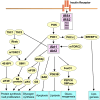Physiological and pathophysiological actions of insulin in the liver
- PMID: 39231651
- PMCID: PMC11850106
- DOI: 10.1507/endocrj.EJ24-0192
Physiological and pathophysiological actions of insulin in the liver
Abstract
The liver plays an important role in the control of glucose homeostasis. When insulin levels are low, such as in the fasting state, gluconeogenesis and glycogenolysis are stimulated to maintain the blood glucose levels. Conversely, in the presence of increased insulin levels, such as after a meal, synthesis of glycogen and lipid occurs to maintain the blood glucose levels within normal range. Insulin receptor signaling regulates glycogenesis, gluconeogenesis and lipogenesis through downstream pathways such as the insulin receptor substrate (IRS)-phosphoinositide 3 (PI3) kinase-Akt pathway. IRS-1 and IRS-2 are abundantly expressed in the liver and are thought to be responsible for transmitting the insulin signal from the insulin receptor to the intracellular effectors involved in the regulation of glucose and lipid homeostasis. Impaired insulin receptor signaling can cause hepatic insulin resistance and lead to type 2 diabetes. In the present study, we focus on a concept called "selective insulin resistance," which has received increasing attention recently: the frequent coexistence of hyperglycemia and hepatic steatosis in people with type 2 diabetes and obesity suggests that it is possible for the insulin signaling regulating gluconeogenesis to be impaired even while that regulating lipogenesis is preserved, suggestive of selective insulin resistance. In this review, we review the progress in research on the insulin actions and insulin signaling in the liver.
Keywords: Insulin receptor signaling; Insulin resistance; Selective insulin resistance.
Conflict of interest statement
The authors have nothing to disclose.
Figures

Similar articles
-
PGC1A regulates the IRS1:IRS2 ratio during fasting to influence hepatic metabolism downstream of insulin.Proc Natl Acad Sci U S A. 2019 Mar 5;116(10):4285-4290. doi: 10.1073/pnas.1815150116. Epub 2019 Feb 15. Proc Natl Acad Sci U S A. 2019. PMID: 30770439 Free PMC article.
-
Differential hepatic distribution of insulin receptor substrates causes selective insulin resistance in diabetes and obesity.Nat Commun. 2016 Oct 6;7:12977. doi: 10.1038/ncomms12977. Nat Commun. 2016. PMID: 27708333 Free PMC article.
-
How insulin receptor substrate proteins regulate the metabolic capacity of the liver--implications for health and disease.Curr Med Chem. 2008;15(13):1316-29. doi: 10.2174/092986708784534956. Curr Med Chem. 2008. PMID: 18537611 Review.
-
Insulin regulation of gluconeogenesis.Ann N Y Acad Sci. 2018 Jan;1411(1):21-35. doi: 10.1111/nyas.13435. Epub 2017 Sep 3. Ann N Y Acad Sci. 2018. PMID: 28868790 Free PMC article. Review.
-
[Mechanism of Yupingfeng Powder on hepatic insulin resistance in type 2 diabetes mellitus rats by regulating IRS/PI3K/Akt pathway].Zhongguo Zhong Yao Za Zhi. 2024 Jun;49(12):3280-3287. doi: 10.19540/j.cnki.cjcmm.20240220.401. Zhongguo Zhong Yao Za Zhi. 2024. PMID: 39041090 Chinese.
Cited by
-
From Childhood Obesity to Metabolic Dysfunction-Associated Steatotic Liver Disease (MASLD) and Hyperlipidemia Through Oxidative Stress During Childhood.Metabolites. 2025 Apr 24;15(5):287. doi: 10.3390/metabo15050287. Metabolites. 2025. PMID: 40422865 Free PMC article. Review.
-
Multi-Omics Sequencing Dissects the Atlas of Seminal Plasma Exosomes from Semen Containing Low or High Rates of Sperm with Cytoplasmic Droplets.Int J Mol Sci. 2025 Jan 27;26(3):1096. doi: 10.3390/ijms26031096. Int J Mol Sci. 2025. PMID: 39940864 Free PMC article.
-
Quercetin as an Anti-Diabetic Agent in Rodents-Is It Worth Testing in Humans?Int J Mol Sci. 2025 Jul 31;26(15):7391. doi: 10.3390/ijms26157391. Int J Mol Sci. 2025. PMID: 40806520 Free PMC article. Review.
References
-
- Bechmann LP, Hannivoort RA, Gerken G, Hotamisligil GS, Trauner M, et al. (2012) The interaction of hepatic lipid and glucose metabolism in liver diseases. J Hepatol 56: 952–964. - PubMed
-
- Nordlie RC, Foster JD, Lange AJ (1999) Regulation of glucose production by the liver. Annu Rev Nutr 19: 379–406. - PubMed
-
- Weickert MO, Pfeiffer AF (2006) Signalling mechanisms linking hepatic glucose and lipid metabolism. Diabetologia 49: 1732–1741. - PubMed
-
- Di Guglielmo GM, Drake PG, Baass PC, Authier F, Posner BI, et al. (1998) Insulin receptor internalization and signalling. Mol Cell Biochem 182: 59–63. - PubMed
-
- Valera Mora ME, Scarfone A, Calvani M, Greco AV, Mingrone G (2003) Insulin clearance in obesity. J Am Coll Nutr 22: 487–493. - PubMed

